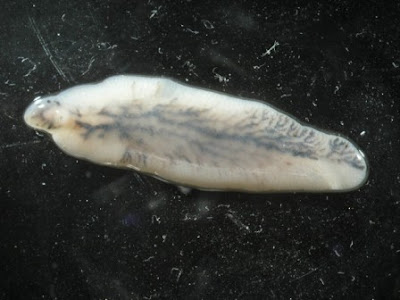I think it is a given that you should not drink water from ponds or lakes if you do not have the means to filter it. When hiking or backpacking, sometimes you do have to drink water from rivers or streams because you cannot bring a lot of clean water. In third world countries, sometimes clean water is not an option. It is important to be educated about infections or diseases that can be acquired by drinking contaminated water, and one such infection is fascioliasis.
What makes this infection interesting is its relationship with snails. This relationship is important in the life cycle of the parasite that causes this condition, but also gives us a hint on how to prevent this infection.
General Description:
Fascioliasis is a parasitic infection caused by a species of flatworms named fasciola hepatica, also known as liver flukes. The flatworms invade the liver and bile ducts and cause damage as they develop. They mainly infect livestock, but in some occasions they infect people. The life cycle of the liver fluke is divided into two stages: (1) while it develops in a sail, and (2) while it develops in its host (livestock or humans). Fascioliasis is acquired by eating raw contaminated foods or drinking contaminated water. Symptoms depend on the stage of infection and a treatment is available to the public.
 |
| Picture of fasciola hepatica in its mature stage. |
Locations:
This infection is present in many areas around the world, however there are some locations were infection is more common than others. The most infected areas are Bolivia and Peru and other locations include tropic regions in Africa and Asia.
Infection Method:
The life cycle of the liver fluke begins with eggs that pass from stool of infected animals. These eggs hatch and the larvae of the fluke find a snail host. The fluke needs the snail to develop into an infectious flatworm. Once a mature flatworm gets ingested by a mammalian host, like a human, it migrates from the intestines to the liver and bile duct. Symptoms arise while the flatworm is migrating to the bile duct and when it is established there these symptoms begin to show in a few days after infection or can even take a few months.
 |
| Life cycle of the liver fluke. |
Symptoms:
The symptoms for this infection depends on which phase the patient in currently in. The first phase experienced is the acute phase. This phase occurs when the liver fluke is migrating out of the intestines and trying to find the bile duct. The parasite eats its way through the tissues, causing damage to the tissues and bleeding. Some of the symptoms experienced in this phase include:
- fever
- nausea
- swollen liver
- skin rashes
- abdominal pain
Once the fluke has situated itself in the bile duct, the patient enters the chronic phase of the infection. During this phase, the fluke begins to produce eggs that pass in the stool. The symptoms of this phase include:
- anemia
- gallstones
- bacterial infections
- hardened liver
- long-term inflammation
Treatment:
Fascioliasis is mainly diagnosed by examining for eggs in the stool. This can only be done in the chronic phase of the infection. Even then if the infection is light, it may be difficult to find eggs in the stool. If it is suspected that a patient has fascioliasis, blood exams can be conducted to see if that patient has a high white blood cell count, which indicates an infection in the body.
There is a drug, triclabendazole, that can be given to treat this condition in the United States and most people have responded well to this treatment.
Final Thoughts:
The life cycle of this parasite and cycle of infection is interesting to think about. It is scary that this parasite eats its way to your liver and the symptoms associated with that are not to be taken lightly. I think that if you are hiking or backpacking, say in Peru, a good idea would be to pay attention to snails in a water source. That would mean there is a chance that the water could be contaminated with liver flukes. Make sure that your water filters can catch these flukes if you plan to drink that water. If you already have the infection based on the symptoms listed above, see your physician often to check for eggs if you are in the chronic stage or get blood tests if in the acute stage.
This infection is more common in livestock but should not be neglected because of that. I hope you all found this post interesting and informative. Leave a comment or recommendation of infection you all would like to know about!
References:



No comments:
Post a Comment